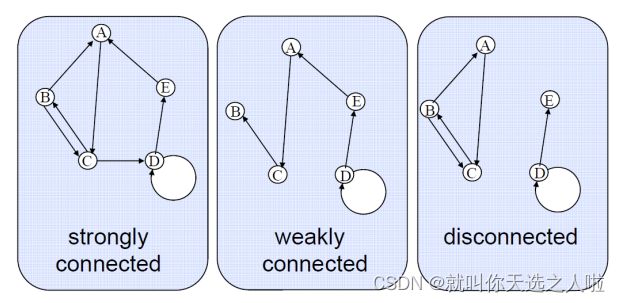图(课堂笔记)
图的引入与术语
两种图
1. 有向图(Digraph):Each edge of arc has an associated direction.
2. 无向图(non-directed graph):Every edge or arc is two-way.
简单图是一种特殊的无向图。无向图没有自环(self-loop)和重复的边。
树
树是一个没有环(loop)的图。
有向图的表示
1. G=(N,A)
N={ a, b, c }
A={ (a,a), (a,c), (b,a), (c,a), (c,b) }
2. G=( {a, b, c}, { (a,a), (a, c), (b,a), (c,a), (c,b) } )
术语
1. Weight:The number of nodes is sometimes called its weight.
2. (a, b):Node "b" is said to be adjacent to node "a"; "a" is the out-node, b is the in-node.
3. Arc can't be duplicated:Can't have two (a, c), but can exist a (c, a).
4. Maximum possible number of arcs:If weight is w, maximum number of arcs is w^2.
5. Full gragph:A directed graph contains the w^2 is called full graph.
6. Density:If there are a arcs and w nodes, the density is a/w^2.
7. Complementary Graph:The complementary graph of G called G*, which contains all the nodes of G and all the possible arcs not present in G.
Density(G*) =1 - Density(G).
(G*)*=G
8. Partial(Reduced) Graph:A partial (reduced) graph of G contains all the nodes of G, one or more arc deleted.
9. Subgraph: A subgraph of G contains one or more node deleted, all the arcs deleted which are associated with one or more of the deleted nodes.
10. Paths:A path of a graph G is an ordered set of nodes such that each node is adjacent to its predecessor.
Path=(b,a,c,a,a)
arcs of Path=((b, a), (a, c), (c, a), (a, a))
11. Length:The number of arcs it contains
对于上面的Path,the length is 4.
12. Simple(elementary) path:The path which doesn't visit any node more than once.
(c, b, a) is a simple path.
13. Loop:A path whose initial and final nodes are the same.
(c, b, a, a, c) is a loop.
14. Simple Loop:A loop which becomes a simple path if its final node is deleted.
(c, b, a, c) is a simple loop.
15. Distance:The length of the shortest path between the nodes.
16. Diameter:The largest Distance which can be found in a graph.
G : ((b, a), (a, c)) and ((a, c), (c, b))
There are shortest paths of length 2.
None of length 3.
So the diameter of G is 2.
17. In and Out Degree:A node has degree(p,q) if p arcs point to it, and q arcs leave it.
18. Connectivity:
Strongly Connected:一个有向图是强连通的,如果从图中的任意一个顶点出发,可以通过有向路径到达图中的任意其他顶点。
Weakly Connected:一个有向图是弱连通的,如果将有向图中的所有有向边都看作无向边后,所得到的无向图是连通的。
Disconnected:一个有向图是不连通的,如果其中至少存在两个顶点,这两个顶点之间无法通过有向路径相互到达。
对于无向图而言,既是连通的,也是非连通的,没有强弱连通的概念之分。
